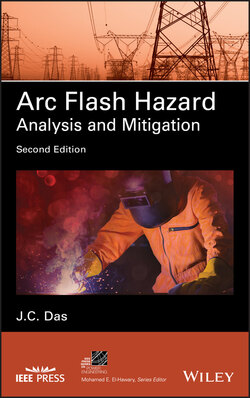Читать книгу Arc Flash Hazard Analysis and Mitigation - J. C. Das - Страница 37
1.13.1 NFPA Table 130.7(C)(15)(a)
ОглавлениеNFPA table 130.7(C)(9)(a) [17] relates the hazard risk category and PPE with respect to maintenance tasks to be carried out on energized equipment within arc flash boundary For example, if a worker is inserting or removing a starter “bucket” from MCC, the risk category is 3, but if he is just reading a panel meter while operating a meter switch, the risk category is zero. This table is applicable for specific three-phase short-circuit currents for specific durations as specified in the many foot-notes to the table. The IEEE equations are based upon an arc in an enclosure, with one side open, and it seems logical to relate the hazard level with respect to task activity; the following observations apply:
All commercially available computer programs calculate the arc flash hazard for a bus fault. It is opined that for safety and conservatism, HRC for a bus fault should be considered. For example, the HRC for a fault downstream of a low voltage or medium voltage MCC (a fault on the load side of the motor starter) can be zero, while for a fault on the bus, cleared by an upstream device, it can be 3 or 4. MCC as a whole is labeled for the bus fault—a fault on the bus can shatter the isolation partition in the MCC on arc blast pressure, unless the equipment is arc resistant.
It will be practically difficult to provide multiple arc flash hazard labels on the same equipment, and lay down procedures for various personal protective outfits based upon the maintenance task to be performed.
A rigorous calculation procedure for task-based HRC is not available, though guidelines in this table can be applied.
Multiple tasks are normally performed in one single instance.
The recommendations of the table can be misapplied (see Section 3.13).
The table is judgmental; there are no mathematical calculations.
The calculations, examples, and study cases in the book consider a bus fault, which gives maximum HRC on an equipment and ignore the nature of the task activity.
